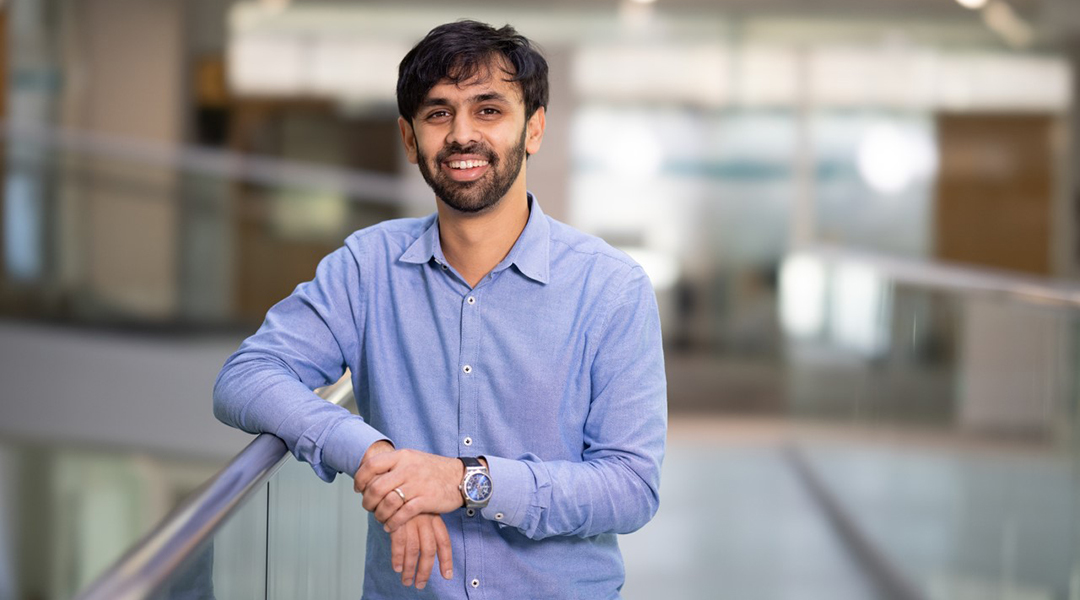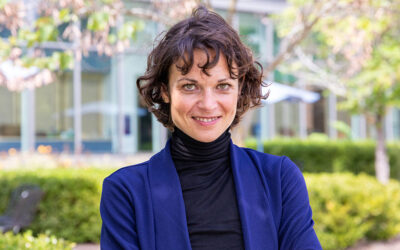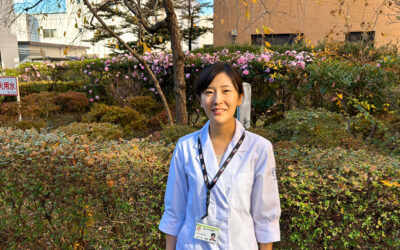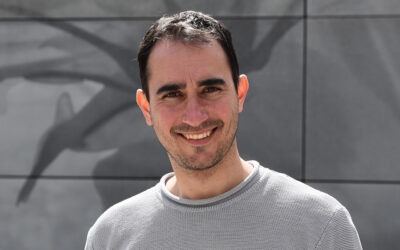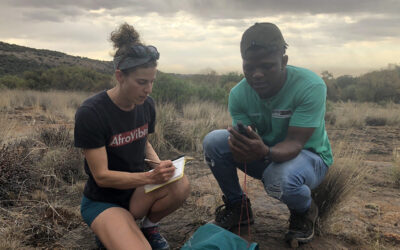With his laboratory at the European Molecular Biology Laboratory (EMBL) in Heidelberg, Germany, biologist Gautam Dey investigates the evolution of cellular organization to identify the origin of the nucleus — the control center of the cell that hosts the DNA.
Developing a lipid- and protein-based compartment to protect the DNA within a cell is a fascinating evolutionary solution that prokaryotic organisms, such as bacteria and archaea, appear to have never converged on. To find out “why” and, perhaps most importantly, “how” the nucleus evolved, the Dey lab applies different imaging and DNA-editing techniques to untangle the mysteries behind a vital building block of all eukaryotic life.
Dey was kind enough to chat with us about his evolutionary expedition, which he hopes will answer some fundamental questions in biology.
Where did you grow up?
My father worked for the United Nations so we moved around quite a bit — I was born in Cyprus, and we then lived in Switzerland for a short while before my parents realized they wanted their kids to grow up in India. We moved there when I was seven and my sister was two years old.
I had my undergraduate and master’s education in India, and I moved to the United States for my Ph.D. at Stanford in the Chemical and Systems Biology Department. My post doc was at UCL in London, and then I started my group at EMBL in 2021.
When did you decide to become a scientist?
I do not think I ever had one of these ‘eureka’ moments that everyone talks about — more like a series of small events that added up to push me in this direction.
My father had this slightly weird strategy of forcing me to read tons of books about science, economics, politics, everything, really when I was a teenager in the hope that something would light a spark – and it did! I remember specifically at the time reading Richard Dawkins’ books about evolution, the start of a lifelong passion. Unfortunately, Dawkins himself has become somewhat of a controversial character in recent years, but I hope his books will stand the test of time as a captivating introduction to a complex subject.
I was lucky to have really good science teachers in high school, and later a rewarding summer research experience as an undergraduate – experiences that crystallized this nascent desire to be a scientist.
Can you tell us about the research focus of your laboratory at EMBL, namely the evolutionary cell biology of the nucleus?
We are very interested in the core functions, evolutionary origins, and phenotypic diversity of this one organelle [the nucleus] that all eukaryotes share and is two billion years old. At one level, it is extremely conserved — in every cell, it protects the DNA, regulates transport between nucleoplasm and cytoplasm, and doubles up as a structural scaffold through its links to the cytoskeleton. At the same time, we are discovering that the nucleus is hugely plastic in its dynamics through the cell cycle and structural composition in terms of its protein and lipid constituents.
We are deeply interested in this apparent contradiction and dichotomy. Why does it have such fundamental functions yet have evolved in so many different ways to address those functions?
We aim to take a comparative approach, drawing on a more naturalist tradition and combining it with the tools of cutting-edge molecular and cell biology. We believe that if we take a step back and look at the diversity of cellular life on our planet, to the extent that we can, then perhaps we will learn some universal principles and the reasons why certain species specialize this organelle along the way.
Do you have an idea when approximately the nucleus evolved?
This was one of the questions that drew me to the field in the first place. It is relatively clear that the nucleus emerged hand-in-hand with the evolution of eukaryotes. Whether it was the causal event or an accompanying event, people do not yet know, but this happened about two billion years ago.
It almost certainly, based on genomic evidence, occurred through a merger between archaea and bacteria [prokaryotic single cell organisms that do not contain any cell organelles]. Why it evolved remains the big question. It could have something to do with protection from cytoplasmic pathogens, or maybe it was simply a remnant of the original host cell. An intriguing theory posits the nucleus originated from an ancient viral infection, based on data showing that certain viruses that can assemble nucleus-like compartments inside cells.
What brought me to my postdoc lab was actually a new theory of how the nucleus evolved that my advisor and his cousin wrote! These various theories have all remained in the realm of speculation and thought experiments — difficult to disentangle because eukaryogenesis was such an ancient event.
To solve this conundrum in the lab will be difficult but maybe not impossible — in large part because people are inching ever closer to identifying the closest living archaeal and bacterial relatives of the lineages that gave rise to eukaryotes.
Why is this research important and what are the applications?
As with all basic research, it is not always obvious what the applications are – or will be, one day in the hypothetical future. We make the broader argument that when you study a fundamental question and try to understand how something works, the applications will naturally follow, often in completely unanticipated ways. Moreover, it is very difficult to disentangle cause and consequence when you study a very complicated system.
If you study the nucleus and its dysfunction in human cells or disease, you are immediately faced with thousands of proteins involved in multiple interacting pathways, which are coupled in very complex ways. To disentangle what is important for function, or dysfunction, from what is not, is entirely non-trivial. An evolutionary perspective can help!
A helpful analogy: if aliens were to come to this planet and try to figure out how a car works, and you give them one car, they might conclude that its ‘purpose’ or ‘function’ is to have a grill or two front lights or a windshield wiper. If you give them a car and a truck and a SUV, they will quickly figure shared universal principles. They have a drive train, a steering wheel and brakes, for example. Eventually it will become clear that all the other stuff is bells and whistles, superficial adaptations to a specific function, or in fact entirely non-adaptive.
What kind of experimental approach does your lab apply to uncover the function of the nucleus?
We have three parallel approaches. One is experimental cell biology in multiple model systems — including fungi, deep-branching relatives of animals, and slime moulds. We try to pick systems that are somewhat understudied but where some tools are still available or in development, so that they are at least amenable to imaging and perturbation approaches.
We use comparative phylogenetics [evolutionary relation and history among groups of organisms] to link phenotypes in our model systems to their genomes and proteomes. Finally, we use experimental lab evolution in yeast to come at the question from the other side, so to speak. Rather than comparing naturally evolved organisms separated by millions of years, we take a system and try to push it to evolve it away from its evolutionary steady state.
Doing all these things at the same time is not trivial. It requires recruiting talented people that actually have these skills and are happy to apply them to challenging questions, and I consider myself exceptionally lucky in this regard. Not counting the summer students and Masters students, we are six people, including myself, in the lab. I could not be happier with my team!
What kind of model organisms are you using for your research and what is really special about them?
We are a bit opportunistic about this. For example, one group we have made some progress with, in collaboration with colleagues at EMBL and EPFL are marine microbial eukaryotes called Ichthyosporea. They are deep branching relatives of animals and inform us about early animal evolution but also the ancient divergence between animals and fungi. They are quite widely distributed in the world’s oceans but very understudied. Omaya Dudin, a friend and colleague at EPFL, is pioneering their use as models for cell and developmental biology, and we are studying their nuclear organization together.
There are many other species that fulfill similar criteria, but sadly we cannot work on all of them, and certainly not alone. If I hadn’t Zoomed with Omaya mid-pandemic, we would never find ourselves working on Ichythyosporea. This kind of research is only possible in close collaboration with model system experts – something especially critical with understudied, emerging model systems.
Who was your biggest supporter along the way?
I’ve had several – it takes a village! My wife, Tonu Basu, who works in international policy, has been my biggest supporter since we were both naïve, idealistic university students. She keeps me grounded when, for example, I am complaining about a day at the lab. That really helps!
I was extremely lucky to have very good and supportive teachers and educators throughout my time in India. It would have been hard to survive a grueling and competitive education system — often focused on rote learning rather than creativity — without their support.
Veronica Rodrigues, Mukund Thattai, and Jitu Mayor at the National Centre for Biological Sciences in India, my first research mentors, were instrumental in shaping my career and deserve at least partial credit for any success I’ve had since then.
Of course, my PhD advisor, my postdoc advisor, and a world of amazing collaborators and friends have carried me through my many years of training and job market uncertainty – but perhaps in some ways the support you get early in your career matters the most.
What advice do you have for future scientists?
We live in uncertain times, when fundamental research seems like a luxury we can ill-afford in the face of pandemics, climate change, and war. Of course, what we really should be doing is pouring even more money into basic science. It is from an open-ended search for knowledge that our most transformative discoveries have emerged — including those that underpin our greatest technologies and most of modern medicine. As a community, we need to do more to take the rest of our fellow citizens along for the ride – tear down that ivory tower, make science more of a collaborative human endeavor and in doing so, move it ever further from its origins as a hobby for wealthy academics.
What is…
Your favorite dish?
King prawns or lobster grilled on an open flame with east Asian or South Asian spices.
A hobby you pursue in your free time?
I used to do a lot of theater, which I miss. I haven’t found a way to do much in many years, theatre practice was never really compatible with long time-courses at the bench! I do some amateur photography, particularly of people.
A place you would love to travel to right now?
I would really like to go to Japan. I have never been and I am looking for a good excuse to get myself over there!
A song you have on constant repeat?
REM’s Losing my Religion is a song that I’ve been weirdly obsessed with since college. No idea why!
Who would play you in a biopic?
Gael Garcia Bernal! He played Che in The Motorcycle Diaries. When he has a beard and looking a bit unkempt, people tell me they see a slight resemblance!
A discovery from any period or time you wish you would have made?
The discovery of CRISPR and of bacterial immunity in general – the mind-warping discovery that bacteria have adaptive immune systems had a massive impact on basic science, technology, and maybe even one day, a transformative impact on human health.
A person (famous or not) you would like to have brunch with?
Merlin Sheldrake, fungal biologist and general adventurer, is the author of a fascinating book called The Entangled Life of Fungi. This is an insane and joyful exploration of how crazy fungal biology is, and how they permeate every aspect our lives. We’re roughly the same age and he seems like fun. A brunch I would look forward to!

